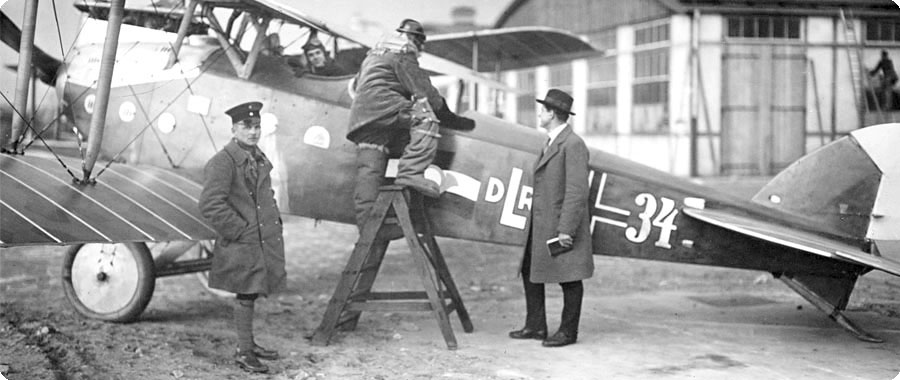Adlershof
is a district in the borough Treptow-Köpenick
of Berlin, Germany. The area known today as the »City of
Science, Technology and Media«, was once known as the Johannisthal
Air Field, located 10 miles southeast of Berlin. Germany’s first
motorized aircraft took off from here at the beginning of the
20th century. It opened on 26 September 1909. Albatros, Fokker,
Rumpler and Wright made Adlershof-Johannisthal famous. In 1912
the German Experimental Institute for Aviation (Deutsche Versuchsanstalt
für Luftfahrt – DVL) made Adlershof its headquarters.
Laboratories, motor test beds, wind tunnels and hangars were
erected in the 20s and 30s and are historical landmarks today.
Adlershof is particularly well known for a series of competitions
between various fighter aircraft designs that were held there
starting in 1918. This was the first time the pilots themselves
were asked for their input into the selection process; they
resoundingly asked for higher speed as opposed to manuverability,
which the Idflieg had always assumed was most important.
The
first of these contests, held in January 1918, led to the Fokker
D.VII winning the competition and going on to become one of
Germany’s most feared planes. A second competition in May and
June led to the acceptance of several of the main contest entries,
the Pfalz D.XII, Fokker E.V, Junkers D.I and Siemens-Schuckert
D.IV, the later of which is considered by many to be Germany’s
best design of the war. All three were put into production largely
in order to make up for the slow production of the Fokkers, although
only the Pfalz design could be found in any number. A final war-time
contest in October was too late to have any effect on the war
effort. Even after the war the process continued, with a fourth
competition between February and May 1919, but the signing of
the Versailles Treaty ended all military aircraft work in Germany.
After
World War II, the airport was closed and three institutions determined
from then on Adlershof’s destiny: The Ministry of State Security
(MfS) stationed its 12,000 strong Guard Regiment there. In 1952
East Germany’s National Television began broadcasting from Adlershof.
And the East German Academy of Science was established with nine
scientific institutes in the fields of physics and chemistry.
»Scientific Equipment Engineering« with its approx.
1,700 workers developed and produced a majority of East Germany’s
research equipment.
After German reunification, the guard regiment was dissolved
and the fate of the Academy was sealed by the German Unification
Treaty: The research facilities of the Academy were subjected
to an evaluation marathon by the German Science Council (Wissenschaftsrat),
which established that there were about 1,500 Academy employees
who ought to be placed in new research structures. For the
rest of the former employees, it was recommended that they
either find new jobs or start their own companies. So of the
250 newly founded companies, approx 100 were founded by ex-academy
workers.
In September 1991 the State of Berlin founded the »Adlershof
Development Society« (EGA), from which WISTA-MANAGEMENT
GMBH emerged in 1994. In 1992 the Berlin Senate decided to establish
an "integrated scientific and business landscape" on
the Adlershof site and made building investments amounting to
about 230 million Euros. The goal was to bring together the synergies
from science and industry, innovation to market. To encourage
innovative businesses to settle here, modern specialised centres
were established on the premises, some in reconstructed old buildings,
and others in new buildings with spectacular architecture.
At the
end of 1991 the decision was made to relocate the mathematics
and natural science faculties of the Humboldt University of
Berlin to Adlershof. In 1998 the Department of Computer Science
moved to Adlershof, followed by the Departments of Mathematics
in 2000, Chemistry in 2001, and Physics, Geography and Psychology
in 2003.
(From: Wikipedia,
GNU-License)) |

